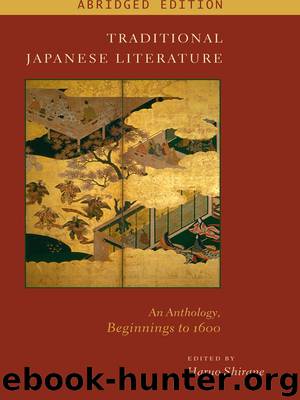Traditional Japanese Literature by Haruo Shirane

Author:Haruo Shirane [Shirane, Haruo]
Language: eng
Format: epub
Tags: FIC003000, HIS050000, Fiction/Anthologies (multiple authors), History/Asia/Japan
ISBN: 9780231504539
Publisher: Columbia University Press
Published: 2012-10-16T04:00:00+00:00
SAIGYŌ
Satō Norikiyo, now known as Saigyō (1118–1190), was the son of a wealthy family of hereditary warrior aristocrats. At the age of fifteen, he entered the service of the powerful Tokudaiji family, and later he served the retired emperor Toba as one of the Northern Guard (Hokumen no bushi), a select group of military bodyguards. Members of the Northern Guard also served as cultural companions to the retired emperor, exhibiting skill in poetry, music, kemari,1 and other aristocratic pastimes. For reasons still being debated, in 1140, at the age of twenty-three, Saigyō suddenly abandoned his post and his family to become a Buddhist monk. For the next fifty years, Saigyō alternately lived in seclusion, traveled about the country, spent time in the capital, and carried out various Buddhist activities. Throughout his tonsured life, Saigyō continued to compose poetry, increasing his fame. The pinnacle of Saigyō’s poetic influence came fifteen years after his death, when ninety-four of his poems (more than those of any other poet) were included in the imperially sponsored Shinkokinshū (New Collection of Ancient and Modern Poems, ca. 1205).
Although reliable historical documents concerning Saigyō’s life are scarce, the autobiographical nature of many of his poems has fed the imagination of readers for centuries, giving rise to a vast body of semilegendary material. “The Woman of Pleasure at Eguchi,” from the Tales of Renunciation (Senjūshō), is a good example of how Saigyō’s poems became the object of legends. It now is nearly impossible to separate the legend Saigyō from the actual poet and his poems. Saigyō spent many years in and around the capital and nearly thirty years in relative seclusion near Mount Kōya, the headquarters of the Shingon Buddhist establishment. He is best known as a travel poet, making the long and arduous trip to Michinoku (northeastern Honshū) twice—once shortly after becoming a monk and again when he was around sixty-nine years of age. He also traveled to Shikoku, Kumano, and Ise, where he spent the duration of the Genpei (Heike/Genji) war (1180–1186). After the fighting ended, Saigyō returned to the capital and then to Kawachi (near present-day Osaka), where he lived out his remaining years, dying on the sixteenth day of the Second Month in 1190.
Although Saigyō composed poetry covering the entire range of traditional waka topics, his most famous poems are on travel, reclusion, cherry blossoms, and the moon. Travel was an established category in both waka composition and the imperially sponsored anthologies. Later interpreters and scholars have perceived a special sense of immediateness in Saigyō’s travel poetry. Many waka poets never saw the poetic sites they described in their poems, relying instead on established associations of poetic place-names. Even though Saigyō is known for his travels, he also composed many poems on famous places without visiting them.
Similarly, it is not entirely clear just how secluded from the world Saigyō was. He likely lived alone in the capital or far away in Kōya or Ise, but he probably was never in total seclusion. Rather, he lived near and associated with others who had abandoned the world.
Download
This site does not store any files on its server. We only index and link to content provided by other sites. Please contact the content providers to delete copyright contents if any and email us, we'll remove relevant links or contents immediately.
| Books & Reading | Comparative Literature |
| Criticism & Theory | Genres & Styles |
| Movements & Periods | Reference |
| Regional & Cultural | Women Authors |
4 3 2 1: A Novel by Paul Auster(12281)
The handmaid's tale by Margaret Atwood(7678)
Giovanni's Room by James Baldwin(7189)
Asking the Right Questions: A Guide to Critical Thinking by M. Neil Browne & Stuart M. Keeley(5632)
Big Magic: Creative Living Beyond Fear by Elizabeth Gilbert(5610)
Ego Is the Enemy by Ryan Holiday(5294)
The Body: A Guide for Occupants by Bill Bryson(4974)
On Writing A Memoir of the Craft by Stephen King(4863)
Ken Follett - World without end by Ken Follett(4645)
Adulting by Kelly Williams Brown(4487)
Bluets by Maggie Nelson(4473)
Eat That Frog! by Brian Tracy(4434)
Guilty Pleasures by Laurell K Hamilton(4360)
The Poetry of Pablo Neruda by Pablo Neruda(4038)
Alive: The Story of the Andes Survivors by Piers Paul Read(3968)
White Noise - A Novel by Don DeLillo(3953)
Fingerprints of the Gods by Graham Hancock(3940)
The Book of Joy by Dalai Lama(3899)
The Bookshop by Penelope Fitzgerald(3775)
